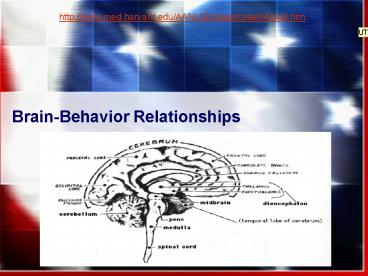BrainBehavior Relationships PowerPoint PPT Presentation
1 / 30
Title: BrainBehavior Relationships
1
Brain-Behavior Relationships
http//www.med.harvard.edu/AANLIB/cases/caseNA/pb9
.htm
2
Cerebrum
- 85 of Brains Weight
- Thinking
- Problem Solve
- Reason
3
Cerebellum
- Back of the brain
- Controls Balance, Movement and Coordination
4
Brain Stem
- Sits beneath the cerebrum and in front of the
cerebellum. - It connects the rest of the brain to the spinal
cord. - In charge of all the functions your body needs to
stay alive. - Controls Involuntary Muscles.
- Sorts information back and forth.
5
Hippocampus
- Memory
- Short Term
- Long Term
- Transfers Information
6
Pituitary Gland
- Produce and Release Hormones such as growth,
puberty, etc - Metabolism
7
Hypothalamus
- Center of the brain
- Regulates Temperature
8
Gross Structures of the Brain
- HINDBRAIN
- Medulla
- Reticular Formation
- Pons and Cerebellum
9
MidBrain
- Controls Sensory Processes
10
Forebrain
- Cerbral Hemispheres
- Each Hemisphere
- Four Lobes
- Frontal
- Thalamus
- Hypothalamus
- and the corpus callosum
11
Cerebral Hemispheres
- Basal Ganglia
- 3 main functions
- In current usage, the phrase 'basal ganglia'
means the caudate nucleus, putamen and globus
pallidus. - Limbic System
- 4 structures
- Cerebral Cortex
12
Cortical Connections
- Between hemispheres (e.g., corpus callosum)
- Within a hemisphere, between one lobe and another
(association tracks e.g., arcuate fasciculus) - Cortex-Subcortical (e.g., internal capsule)
13
Review of Neuroanatomy (cont.)
- Skull and Meninges
- Vascular System
- Ventricular System and CSF
14
Cortical Lobes
15
Cortical Lobes
- Occipital Mediate sight visual perception
visual knowledge - Parietal tactile sensations position sense
spatial relations - Left sequential. Logical spatial
- Right holistic spatial information
16
Cortical Lobes (cont.)
- Temporal auditory and olfactory abilities
integrating visual perceptions with other sensory
info new learning emotion motivation - Frontal motor functions, including speech
executive functions integration of emotional and
motivational states
17
Lateralization of Function
- Left Hemisphere
- Speech and Language
- Linear Processing
- Well-routinized codes
- Details
- Contralateral attention
- Positive Emotions
- Right Hemisphere
- Prosody, Humor, Non-literal
- Configural Processing (faces)
- More adept at novel
- Global Percepts
- Global attention
- Negative Emotions
18
Memory
- Amnesia
- Immediate vs. Long-term
- Remote memory vs. Antereograde memory
- Implicit vs. Explicit Memory
- Frontal Lobes role in retrieval and organization
- The frontal lobes are the most advanced part of
your brain. The frontal lobes are that part of
your brain responsible for creativity, logic,
intuition, new problem solving, synthesis of
ideas, imagination, concepts of time, and
planning.
19
Memory Rehabilitation
Attention
Encoding
Storage
Retrieval
20
Language
- Aphasia
- Expressive Aphasia
- Receptive Aphasia
- Distinguish
- Psychological Issues
21
PREFRONTAL CORTEX SYSTEMThe most evolved brain
system Functions attention span perseverance
planning judgment impulse control organization
self-monitoring and supervision problem solving
critical thinking forward thinking learning
from experience and mistakes ability to feel and
express emotions influences the limbic system
empathy internal supervision
22
Dorsolateral Syndrome
- Executive function deficits
- Poor organizational strategies
- Poor memory strategies
- Working Memory
- Impaired set-shifting
- Attentional control (distractible)
23
Orbitofrontal-Ventral PFC Syndrome
- Stimulus-Reward Associations
- Decision-Making
- Appropriate Social Behavior
- Phineas Gage
24
Anterior Cingulate Syndrome
- Akinetic Mutism
- Apathetic, no spontaneous speech, answer in
monosyllables - Display no emotion
- Cingulotomy Study
25
Points to Remember
- Individual variation.
- Difficulty to develop real-world tasks to assess
FL functioning. - Behavioral deficits determined by site, size,
laterality, nature of lesion, etc.
26
Diseases that commonly affect Frontal functioning
- Affective Disorders
- Depression
- Traumatic Brain Injury
- Schizophrenia
- Some Dementing Illnesses
27
Traumatic Disorders
- Mechanisms of Injury
- Primary
- Secondary
- Initial Assessment of Severity
- Glascow Coma Scale
- Length of Consciousness
- Length of PTA
28
TBI (cont.)
- Treatment
- Cognitive and Emotional Effects
- Rehabilitation
29
Neurotransmitters
- Excitatory (glutamate)
- Inhibitory (GABA)
- Neuromodulators (dopamine)
30
Classes of Psychoactive Medications
- Neuroleptics (Haldol)
- Antidepresants (Prozac)
- Tranquilizers (diazepam or Valium)
- Stimulants (amphetamine)
- Time Course and Side Effects

